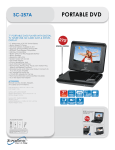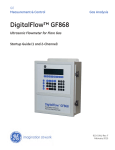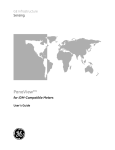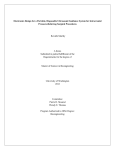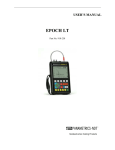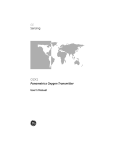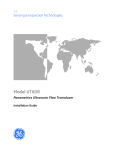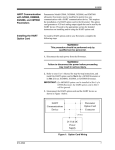Download MODBUS Communications for the GF868
Transcript
5/5/00 MODBUS Communications for the GF868 Your Model GF868 hardware and software have been modified to provide MODBUS communications. The MODBUS option card (703-1358) provides an RS485 interface with a host system, while the main circuit board continues to support RS232 communications for use with a PC running Panametrics’ IDM software. To properly set up the instrument, use this addendum along with the standard GF868 flowmeter User’s Manual (910-194). This document shows how to install the MODBUS option card and how to program the modified GF868 to access this special feature. Installing the MODBUS Option Card IMPORTANT: The installation information presented here supersedes the information in the standard GF868 User’s Manual. The modified GF868 uses the RS485 standard for MODBUS communications. This standard allows up to 32 nodes (drivers and receivers) on one multidrop network, at distances up to 4,000 ft (1,200 m). To connect the instrument(s) to the host system, Panametrics recommends using a 24-gauge (24 AWG) twisted-pair cable with a characteristic impedance of 120 ohms and a 120-ohm termination at each end of the communications line. The MODBUS option card must be plugged into either slot 5 or slot 6 of the GF868. On the option card, pin 1 is the [TMT-] inverting or negative connection and pin 2 is the [TMT+] non-inverting or positive connection. To link the GF868 to the control system, connect the two wires of the twisted-pair cable from these terminals to the corresponding terminals at the control system. Note: If two MODBUS option cards are installed in the GF868, only the card in slot 5 is activated. Setting Up MODBUS Communications To set up MODBUS communications, enter the User Program as described in your User’s Manual. Then, refer to the menu map in Figure 1 on page 7 and complete the following steps: Note: Any time the following settings are changed, the GF868 must be rebooted to load the new settings into the option card. Start É PROGRAM PROGRAM status ACTIV 913-257A SYSTM PIPE I/O Press the [→] key and then the [F3] key to select the COMM submenu. (On a two-channel GF868, pressing the [→] key and the [F3] key accesses the GLOBL menu. Then press [F4] to select the COMM submenu.) 1 5/5/00 Setting Up MODBUS Communications (cont.) IMPORTANT: The serial port settings of the GF868 must match those of the MODBUS control system. É COMM PROGRAM PROGRAM Comm port BAUD RATE current value appears here 4800 9600 [This baud rate applies only to the RS232 serial port.] Press the [→] until the desired RS232 baud rate appears on the option bar and press the appropriate [Fx] function key to select it. 19200 The available RS232 baud rates are 300, 600, 1200, 2400, 4800, 9600, and 19200. É COMM PROGRAM BAUD RATE current value appears here UART bits current setting appears here 8,no 8,odd 8even 7,no [The UART bits setting applies only to the RS232 serial port.] Press the [→] until the desired RS232 UART bits setting appears on the option bar and then press the appropriate [Fx] function key to select it. See Table 1 below for a description of the options available at the above prompt. Option Bar Table 1: UART Bits Options # Data Bits # Stop Bits Parity 8,no 8 0 None 8,odd 8 0 Odd 8even 8 0 Even 7,odd 7 1 Odd 7even 7 1 Even COMM PROGRAM UART bits current setting appears here Network I.D.? current number appears here [The Network ID number is used by the IDM software only.] Enter a Network ID number between 1 and 254 and then press [ENT]. The default ID number is 1. Note: If more than one meter is connected to a network, each meter must have a unique Network I.D. 913-257A 2 5/5/00 Setting Up MODBUS Communications (cont.) COMM PROGRAM Network I.D.? current number appears here Press the appropriate [Fx] function key to select [2400], [4800], or [9600] for the MODBUS baud rate. MODBUS BAUD RATE current value appears here 2400 4800 9600 COMM PROGRAM MODBUS BAUD RATE current value appears here Press the appropriate [Fx] function key to select [NONE], [ODD], or [EVEN] for the MODBUS parity setting. MODBUS PARITY current setting appears here none odd even COMM PROGRAM MODBUS PARITY current setting appears here Press the appropriate [Fx] function key to select [1] or [2] for the MODBUS stop bits setting. MODBUS STOP BITS current setting appears here 1 2 COMM PROGRAM MODBUS STOP BITS current setting appears here Enter a MODBUS Address number between 1 and 247. Then, press [ENT]. MODBUS Address? current address appears here Press [EXIT] until you return to RUN mode and the screen resumes the display of data measurements. Then reboot the meter to load the new settings into memory. 913-257A 3 5/5/00 MODBUS Register Map To request specific parameters from the GF868 via the MODBUS, the control system must enter the appropriate register number. Only registers 1 through 90 are available for MODBUS communications, while registers 508 through 512 are used by the GF868 to store the MODBUS parameters. For details, see Table 2 below for a 1-Channel meter or Table 3 on page 5 for a 2-Channel meter. Note: If you request Ch2 or AVE data from a 1-Channel meter, the values will all be zero. Table 2: MODBUS Registers for a 1-Channel GF868 MODBUS DPR Scaling Reg # Hex Addr Description (decimal places) Size in Bytes 1 0 1” -- 2 (16 bit signed) 2 2 Not Used -- 2 (16 bit signed) 3 4 Velocity 2 4 (2 16-bit int) 5 8 Act Volumetric #Q DIGITS 4 (IEEE 32 bit) 7 C Std Volumetric #Q DIGITS 4 (IEEE 32 bit) 9 10 Fwd Totals #T DIGITS 4 (2 16 bit int) 11 14 Rev Totals #T DIGITS 4 (2 16 bit int) 13 18 #Tot Digits 0 2 14 1A Mass Flow #M DIGITS 4 (IEEE 32 bit) 16 1E Fwd Mass Totals #MT DIGITS 4 (2 16-bit int) 18 22 Rev Mass Totals #MT DIGITS 4 (2 16-bit int) 20 26 #Mass Tot Digits 0 2 21 28 Timer 2 4 (2 16-bit int) 23 2C Error Code 0 2 24 2E Sound Speed 3 4 (2 16-bit int) 26 32 Molecular Weight 4 4 (2 16-bit int) 28 36 Signal Strength Upstream 1 4 (2 16-bit int) 30 3A Signal Strength Downstream 1 4 (2 16-bit int) 32 3E Temperature 2 4 (2 16-bit int) 34 42 Pressure 3 4 (2 16-bit int) 508 3F6 2 MODBUS baud rate 0 2 509 3F8 3 MODBUS parity 0 2 510 3FA 4 MODBUS stop bits 0 2 511 3FC MODBUS meter addr 0 2 512 3FE RESERVED --- --- 913-257A Clear Ch1 Totalizers” 4 5/5/00 Table 3: MODBUS Registers for a 2-Channel GF868 MODBUS DPR Scaling Reg # Hex Addr Description (decimal places) Size in Bytes 1 0 1” 2 2 1“Clear 3 4 Ch1 Velocity 5 8 7 -- 2 (16 bit signed) -- 2 (16 bit signed) 2 4 (2 16-bit int) Ch1 Act Volumetric #Q DIGITS 4 (IEEE 32 bit) C Ch1 Std Volumetric #Q DIGITS 4 (IEEE 32 bit) 9 10 Ch1 Fwd Totals #T DIGITS 4 (2 16 bit int) 11 14 Ch1 Rev Totals #T DIGITS 4 (2 16 bit int) 13 18 Ch1 #Tot Digits 0 2 14 1A Ch1 Mass Flow #M DIGITS 4 (IEEE 32 bit) 16 1E Ch1 Fwd Mass Totals #MT DIGITS 4 (2 16-bit int) 18 22 Ch1 Rev Mass Totals #MT DIGITS 4 (2 16-bit int) 20 26 Ch1 #Mass Tot Digits 0 2 21 28 Ch1 Timer 2 4 (2 16-bit int) 23 2C Ch1 Error Code 0 2 24 2E Ch1 Sound Speed 3 4 (2 16-bit int) 26 32 Ch1 Molecular Weight 4 4 (2 16-bit int) 28 36 Ch1 Sig Strength Upstream 1 4 (2 16-bit int) 30 3A Ch1 Sig Strength Downstream 1 4 (2 16-bit int) 32 3E Ch1 Temperature 2 4 (2 16-bit int) 34 42 Ch1 Pressure 3 4 (2 16-bit int) 36 46 Ch2 Velocity 2 4 (2 16-bit int) 38 4A Ch2 Act Volumetric #Q DIGITS 4 (IEEE 32 bit) 40 4E Ch2 Std Volumetric #Q DIGITS 4 (IEEE 32 bit) 42 52 Ch2 Fwd Totals #T DIGITS 4 (2 16 bit int) 44 56 Ch2 Rev Totals #T DIGITS 4 (2 16 bit int) 46 5A Ch2 #Tot Digits 0 2 47 5C Ch2 Mass Flow #M DIGITS 4 (IEEE 32 bit) 49 60 Ch2 Fwd Mass Totals #MT DIGITS 4 (2 16-bit int) 51 64 Ch2 Rev Mass Totals #MT DIGITS 4 (2 16-bit int) 53 68 Ch2 #Mass Tot Digits 0 2 54 6A Ch2 Timer 2 4 (2 16-bit int) 56 6E Ch2 Error Code 0 2 57 70 Ch2 Sound Speed 3 4 (2 16-bit int) 59 74 Ch2 Molecular Weight 4 4 (2 16-bit int) 913-257A Clear Ch1 Totalizers” Ch2 Totalizers” 5 5/5/00 Table 3: MODBUS Registers for a 2-Channel GF868 (cont.) MODBUS DPR Scaling Reg # Hex Addr Description (decimal places) Size in Bytes 61 78 Ch2 Sig Strength Upstream 1 4 (2 16-bit int) 63 7C Ch2 Sig Strength Downstream 1 4 (2 16-bit int) 65 80 Ch2 Temperature 2 4 (2 16-bit int) 67 84 Ch2 Pressure 3 4 (2 16-bit int) 69 88 Avg Velocity 2 4 (2 16-bit int) 71 8C Avg Act Volumetric #Q DIGITS 4 (IEEE 32 bit) 73 90 Avg Std Volumetric #Q DIGITS 4 (IEEE 32 bit) 75 94 Avg Fwd Totals #T DIGITS 4 (2 16 bit int) 77 98 Avg Rev Totals #T DIGITS 4 (2 16 bit int) 79 9C Avg #Tot Digits 0 2 80 9E Avg Mass Flow #M DIGITS 4 (IEEE 32 bit) 82 A2 Avg Fwd Mass Totals #MT DIGITS 4 (2 16-bit int) 84 A6 Avg Rev Mass Totals #MT DIGITS 4 (2 16-bit int) 86 AA Avg #Mass Tot Digits 0 2 87 AC Avg Timer 2 4 (2 16-bit int) 89 B0 5 Avg Error Code 0 2 90 B2 Avg Sound Speed 3 4 (2 16-bit int) 508 3F6 2 0 2 509 3F8 3MODBUS 0 2 510 3FA 4 MODBUS stop bits 0 2 511 3FC MODBUS meter addr 0 2 512 3FE RESERVED --- --- Notes: MODBUS baud rate parity 1. Clear Totalizers: flag from the 8051 to clear either the Channel 1 or Channel 2 totalizers. 2. MODBUS baud rate: 5 = 2400, 6 = 4800, 7 = 9600 3. MODBUS parity: 0 = none, 1 = odd, 2 = even 4. MODBUS stop bits: 1 = 1 stop bit, 2 = 2 stop bits 5. AVG Error Code: 0=Both Ch1 and Ch2 are in error. 1=Ch1 only is in error 2=Ch2 only is in error 3=Both channels are error free 913-257A 6 5/5/00 1-Ch Meter 2-Ch Meter GLOBL COMM Baud Rate (RS232) F1 300 F2 600 F3 F4 F1 F2 1200 2400 4800 9600 F3 19200 UART Bits (RS232) F1 F2 8,no 8,odd F3 F4 7,odd 8even F1 7even Network I.D.? MODBUS Baud Rate F1 F2 F3 2400 4800 9600 MODBUS Parity F1 F2 NONE F3 ODD EVEN MODBUS Stop Bits F1 1 F2 2 MODBUS Address NOTE: Plain text represents prompt area messages and boxed text represents option bar choices. Fx represent function keys to select option bar choices. Figure 1: MODBUS Menu Map 913-257A 7







